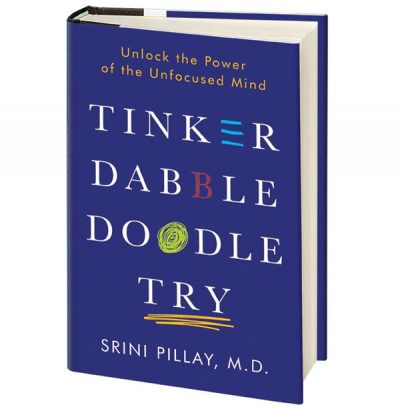A Guide To Guilt-Free Daydreaming
By Srini Pillay
April 27, 2017 • Fact checked by Dumb Little Man

You probably feel guilty, irresponsible, and unproductive when you catch yourself daydreaming during an important task. In the words of Harvard psychologist Matthew Killingsworth and his colleagues: “A wandering mind is an unhappy mind.”
On the surface, the source of this guilt and despair seems obvious. Daydreaming implies you are procrastinating — and nobody likes to waste time or be off-task. Yet, if you look more deeply at the reasons for this guilt, the scene becomes much more complex.
For example, when our minds wander, we feel freer. As philosopher Søren Kierkegaard pointed out, freedom may seem appealing, but it also causes anxiety. This anxiety makes us feel dizzy as if we are without “gravity” when our minds are adrift.
Psychology researcher Jerome Singer confirmed that this type of guilty daydreaming is no good for us. Yet, as he also pointed out, daydreaming can be spectacularly great — but only if we do it the right way.
Daydreaming The Right Way
In my book, “Tinker, Dabble, Doodle, Try,” I explained in detail how daydreaming can lead to glorious outcomes with a few tweaks.
What you want to aim for is called positive constructive daydreaming (PCD) — also known as “daydreaming that rocks!” These sessions of unfocusing can be spontaneous or planned, and they will ultimately make you feel more self-aware, more creative, and far less bored.
When you engage in PCD, you give your focused attention a break and allow yourself to plan and rehearse what’s to come. In other words, if you allow yourself to constructively daydream, you are likely to realize things about the future that you would miss otherwise.
Let your mind wander on a leash; it will lead you to the jewels of self-awareness and illuminate missing information hidden in your brain. When you find these clues, you can connect the dots of your past and present to construct a more accurate prediction of the future.
How to Engage in PCD
PCD is drastically different from the guilty daydreams you suddenly slip into, like the ones about last night’s shenanigans instead of tomorrow’s big meeting. Here are four steps to help you master daydreaming psychology.
Start by planning

Planning a daydream may sound counterintuitive. Just think of it as taking the time to plan a skydive rather than spontaneously jumping out of an airplane.
When you consciously set aside time to daydream, you avoid the shock and dismay of unexpected mind-wandering.
Turn your attention inward
You spend most of the day engaging the world with your senses, which means the majority of what you learn comes from the outside.
Daydreaming is all about closing the door on perception and turning your attention inward. Closing your eyes may help you get disconnected faster.
At first, it may feel like your mind is simply going on a wild goose chase. But, studies show that this is simply your brain’s planning mechanisms just under the radar. If you find it difficult to turn inward at will, try marking the switch with a relaxing chair tilt or a much-needed walk to the window.

Do something low-key
You may think of daydreaming as total downtime, but a recent study claimed otherwise. Daydreaming actually has the potential to improve your creative ability.
Doing nothing at all or something that takes up too much attention will be less effective, so try knitting, gardening, coloring, or light-hearted doodling while you daydream to get your creative brain charged.

See Also: Top Tips On Training Your Brain To Be Creative
Overcome the vomit response
Social psychologist Jennifer Mueller and her colleagues found that although we laud the attributes of a creative mind, we are actually predisposed to hate our own creativity. This goes particularly true during times of uncertainty.
Our brains, without overt warning, associate the word “creativity” with “vomit” and “agony.” Someone else being creative may feel like music to your ears, but once you start to become creative yourself, the music metaphorically becomes haunting and disturbing.
It’s crucial to acknowledge the fact that creativity will cause your stomach to churn. When you find yourself feeling queasy, recognize why you feel this way and keep on truckin’.

The Lowdown
So, what’s the earth-shattering lowdown here?
• Daydreaming can improve your focus, creativity, and self-awareness. It can also help you envision and prepare for the future.
• Set aside a time in your day to veg out.
• Turn your attention inward by switching off your perceptions. Close your eyes to get a quick start.
• Do something low-key or don't do anything.
• Beware of your brain’s tendency to resist, and use self-talk to tell it to chill. Sit back, relax, and daydream yourself to success.
See Also: 5 Top Weird Brain Facts
Srini Pillay
Srini Pillay, M.D., is the CEO of NeuroBusiness Group and the award-winning author of “Tinker Dabble Doodle Try: Unlock the Power of the Unfocused Mind,” available for preorder wherever books are sold; “Life Unlocked: 7 Revolutionary Lessons to Overcome Fear;” and “Your Brain and Business: The Neuroscience of Great Leaders.” He is also Assistant Professor of Psychiatry (Part-time) at Harvard Medical School and teaches in the Executive Education Program at Harvard Business School.



